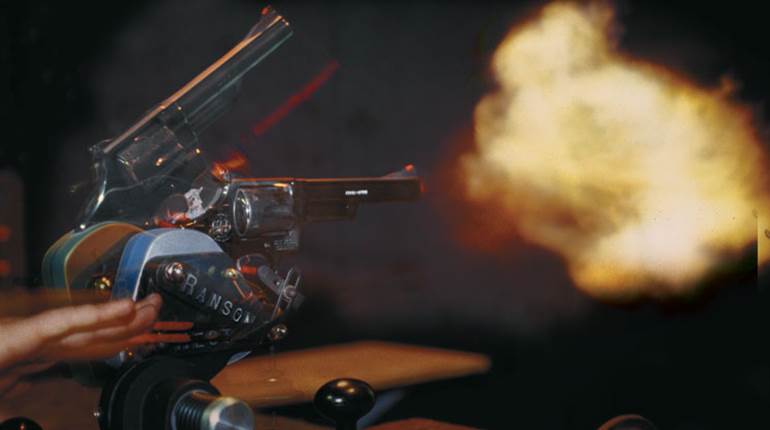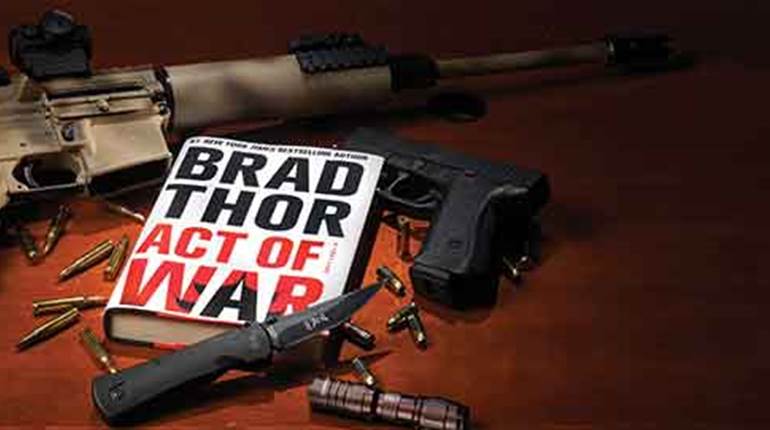
No one is born with a beard,” is an expression my father was fond of repeating to me as I got my start in the business world. It was his way of telling me that experience is won over time. He suggested that I could shift attention away from my inexperience, by assembling a team of experienced people. That was what I did when I began my career in television, and it worked.
When I decided to switch careers and become a thriller author, I did the same thing, especially regarding firearms and tactics. Some of it worked out great, but some of it—because of my own ego—didn’t work out as well as I had planned.
My first novel, The Lions of Lucerne, is about the kidnapping of an American president and the subsequent operations that are launched to get him back. I knew that the key to success would rest in making the novel as gripping and as true-to-life as possible. The gripping part, believe it or not, was easy. It comes with how you tell the tale. The hard part was in nailing the true-to-life elements. How do you do that when most of what you are writing about is classified or close-held material our country would never want its enemies getting their hands on?
Much like launching my career in television, I networked. A good friend of our family was a retired FBI Special Agent in Charge, who had run several field offices across the country. He is very well liked at the Bureau, and he helped open doors for me on the Federal law enforcement side. Without his help, I never would have met the people who taught me about the Secret Service, their Counter Assault Teams, and all manner of close-protection strategies.
On the special operations side, I had a neighbor in college who had been attached to a covert unit in Europe during the Cold War. Through his kindness, I was plugged in to some incredible operators who were exceedingly generous with their time and wisdom. Together, all of these people were my “beards.” It was up to me to take what they had told me and weave it into my story.
Stephen King had a great line that I like to share with young writers when I speak to them, “Write what you love to read. That’s where your passion is. That’s where you’ll be successful.” That’s how I discovered my genre. My passion has always been thrillers. I grew up reading and loving authors such as Frederick Forsyth, John le Carré, Ian Fleming, Sidney Sheldon and Tom Clancy.
Clancy, of course, was known for his incredible technical detail. He could go on for pages about how a particular weapon system worked. His ability in that regard was astounding. It was also, for me as a thriller writer just starting out, daunting.
I firmly believe that success leaves clues. Study what works and you too can be successful. I was also reminded of what the great writer Elmore Leonard liked to say, “Make sure you leave out the parts that people skip.”
Did people want lots and lots of very specific details in their thrillers? Or did they want a story that had them turning the pages so quickly that they caught fire?
It was a watershed moment for me as a beginning writer. I was not writing technical or “How To” manuals. I write fiction. My job is to give you the best, edge-of-your-seat thrill ride I am capable of. I do that by not letting you see around the next corner. I want to keep you in a state of heightened anticipation. I also want you to believe that what you are reading is real—completely real. And most of it is.
I call what I do, “faction.” It’s a mix of fact and fiction, where you don’t know where the facts end and the fiction begins. Tying it all together are the real-life details, particularly my favorites—firearms and tactics. This is the point where my ego came in.
It was an honor to have had access to the caliber of people I did when researching my first thriller. I cannot express how interesting they were to talk to and learn from. I could fill volumes with what they shared with me. In fact, I even tried to.
The first draft of my first thriller was way too long. What about Elmore Leonard’s prohibition? Who’s Elmore Leonard? Never heard of the guy.
I was so concerned with proving that I knew what I was talking about, that I was bogging the story down with details that I guarantee you would have skipped. Bolt carrier groups, trajectory, maximum effective range, LBE modification—none of it propelled the story forward. It was time to pare things down.
If I were going to spend any time on details, they had to be specific items that brought color to the novel. Enter some incredible firearms.
With plenty of the book set in Switzerland, and having a U.S. Secret Service subplot, SIG Sauer featured prominently. SIG pistols, rifles, you name it, they’re in there. Glocks, Berettas, and a myriad of arms from Heckler & Koch are there as well. I was like a kid in a candy store as I hunted down and included all sorts of fantastic gear. I was also careless.
I was, from an early age, enamored with firearms and I grew up as a strong supporter of the Second Amendment, though I had done so in Chicago. The Windy City is not exactly a hotbed of gun culture—at least not when it comes to responsible, law-abiding firearm owners. While proficient with a shotgun, I had little to no experience with handguns or tactical rifles. This caused me to make two mistakes in my first novel that, now, as a significantly more seasoned and better-trained firearm owner, I find a little cringe-worthy.
I wanted to sound like I knew my stuff better than I did, so I used a term I had read in other thrillers: cordite. To my ear, it sounded very inside and very cool—“the smell of cordite lingered in the air.” What a moron, right?
Though social media was in its relative infancy at the time, I heard from knowledgeable gun owners pretty quickly on that one. Every single one of them was polite and offered to help me better understand firearms as I moved forward as a writer. Members of the gun community are like no others I have ever met.
My other big mistake was using the term “clip” instead of “magazine.” Like cordite, it was a term that sounded hip and in-the-know. What I didn’t know was that it was completely wrong. Once again, a kind firearms community set me straight as it did with “pressing” a trigger instead of “squeezing” it.
Looking back, I suppose there were greater sins I could have committed—like putting a safety on a Glock. A writer friend of mine actually did this in one of his novels and had the error pointed out multiple times by his readers.
He had never fired a gun before and had no idea how to get started familiarizing himself with one. As a Life member of NRA, I suggested that his first step be to seek out an NRA certified firearm instructor. Learn the basics, especially the safe handling of firearms, I offered. Have the instructor take you to a range where you can experiment with a variety of firearms. Ask questions, lots of them. Don’t be afraid to appear unknowledgeable. Take your ego out of the equation.
For many Americans, books are a gateway to gun culture. The better we can responsibly describe them, the more accessible they become. In that regard, I see myself as an “ambassador” for the Second Amendment and the responsible gun-owner lifestyle. I love it, and I live it.
As an NRA member, I also believe it is my duty to introduce non-gun-owners to the wonderful world of firearms. And there has been no better time to take our message of responsible firearm ownership forward to our fellow citizens than right now. With victories in the Supreme Court, and on state and local levels, we have the wind at our backs. Now is the time for all of us to be ambassadors and to press our political and public relations advantage—politely and patiently.
We don’t own the Second Amendment, we are merely its stewards. It is our responsibility to see that it is passed to the next generation stronger and more secure. If, along the way, we can convince even more people to join us, then we will have truly done our job as protectors of America’s first and greatest freedom.





































